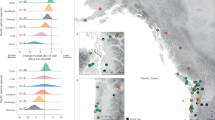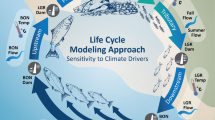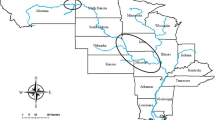Abstract
Rare phenotypes and behaviours within a population are often overlooked, yet they may serve a heightened role for species imperilled by rapid warming. In threatened spring-run Chinook salmon spawning at the southern edge of the species range, we show late-migrating juveniles are critical to cohort success in years characterized by droughts and ocean heatwaves. Late migrants rely on cool river temperatures over summer, increasingly rare due to the combined effects of warming and impassable dams. Despite the dominance of late migrants, other strategies played an important role in many years. Our results suggest that further loss of phenotypic diversity will have critical impacts on population persistence in a warming climate. Predicted thermally suitable river conditions for late migrants will shrink rapidly in the future and will be largely relegated above impassable dams. Reconnecting diverse habitat mosaics to support phenotypic diversity will be integral to the long-term persistence of this species.
This is a preview of subscription content, access via your institution
Access options
Access Nature and 54 other Nature Portfolio journals
Get Nature+, our best-value online-access subscription
$29.99 / 30 days
cancel any time
Subscribe to this journal
Receive 12 print issues and online access
$209.00 per year
only $17.42 per issue
Buy this article
- Purchase on Springer Link
- Instant access to full article PDF
Prices may be subject to local taxes which are calculated during checkout





Similar content being viewed by others
Data availability
The datasets generated and used for the otolith strontium isotope and early-life freshwater growth analyses and to produce Figs. 1–4 and Supplementary Figs. 1–3 are available on GitHub at https://github.com/floracordoleani/MillDeerOtolithPaper (ref. 71). The stream temperature and spring-run Chinook spatial distribution shapefiles generated for the juvenile spring-run Chinook thermal habitat suitability assessment and used in Fig. 5, Extended Data Fig. 1 and Supplementary Fig. 4 are available on DRYAD at https://doi.org/10.5061/dryad.bk3j9kdc9 (ref. 72).
Code availability
The code for the otolith strontium isotope and early-life growth analyses is posted on GitHub at https://github.com/floracordoleani/MillDeerOtolithPaper.
References
IPCC Climate Change 2007: Impacts, Adaptation and Vulnerability (eds Parry, M. L. et al.) (Cambridge Univ. Press, 2007).
Kiehl, J. Lessons from Earth’s past. Science 331, 158–159 (2011).
Parmesan, C. Ecological and evolutionary responses to recent climate change. Annu. Rev. Ecol. Evol. Syst. 37, 637–669 (2006).
Davis, M. B. Range shifts and adaptive responses to quaternary climate change. Science 292, 673–679 (2001).
Chen, I.-C., Hill, J. K., Ohlemuller, R., Roy, D. B. & Thomas, C. D. Rapid range shifts of species associated with high levels of climate warming. Science 333, 1024–1026 (2011).
Williams, J. W. & Jackson, S. T. Novel climates, no-analog communities, and ecological surprises. Front. Ecol. Environ. 5, 475–482 (2007).
Root, T. L. et al. Fingerprints of global warming on wild animals and plants. Nature 421, 57–60 (2003).
Diez, J. M. et al. Forecasting phenology: from species variability to community patterns. Ecol. Lett. 15, 545–553 (2012).
Aubin, I. et al. Traits to stay, traits to move: a review of functional traits to assess sensitivity and adaptive capacity of temperate and boreal trees to climate change. Environ. Rev. 24, 164–186 (2016).
Moran, E. V., Hartig, F. & Bell, D. M. Intraspecific trait variation across scales: implications for understanding global change responses. Glob. Change Biol. 22, 137–150 (2016).
Hilborn, R., Quinn, T. P., Schindler, D. E. & Rogers, D. E. Biocomplexity and fisheries sustainability. Proc. Natl Acad. Sci. USA 100, 6564–6568 (2003).
Greene, C. M., Hall, J. E., Guilbault, K. R. & Quinn, T. P. Improved viability of populations with diverse life-history portfolios. Biol. Lett. https://doi.org/10.1098/rsbl.2009.0780 (2010).
Moore, J. W., Yeakel, J. D., Peard, D., Lough, J. & Beere, M. Life-history diversity and its importance to population stability and persistence of a migratory fish: steelhead in two large North American watersheds. J. Anim. Ecol. 83, 1035–1046 (2014).
Fagan, W. F. Connectivity, fragmentation, and extinction risk in dendritic metapopulations. Ecology 83, 3243–3249 (2002).
Fausch, K. D., Torgersen, C. E., Baxter, C. V. & Li, H. W. Landscapes to riverscapes: bridging the gap between research and conservation of stream fishes. BioScience 52, 483–498 (2002).
Comte, L. & Grenouillet, G. Do stream fish track climate change? Assessing distribution shifts in recent decades. Ecography 36, 1236–1246 (2013).
Troia, M. J., Kaz, A. L., Niemeyer, J. C. & Giam, X. Species traits and reduced habitat suitability limit efficacy of climate change refugia in streams. Nat. Ecol. Evol. 3, 1321–1330 (2019).
Beechie, T., Buhle, E., Ruckelshaus, M., Fullerton, A. & Holsinger, L. Hydrologic regime and the conservation of salmon life history diversity. Biol. Conserv. 130, 560–572 (2006).
Barbarossa, V. et al. Impacts of current and future large dams on the geographic range connectivity of freshwater fish worldwide. Proc. Natl Acad. Sci. USA 117, 3648–3655 (2020).
FitzGerald, A. M., John, S. N., Apgar, T. M., Mantua, N. J. & Martin, B. T. Quantifying thermal exposure for migratory riverine species: phenology of Chinook salmon populations predicts thermal stress. Glob. Change Biol. 27, 536–549 (2021).
Schindler, D. E. et al. Population diversity and the portfolio effect in an exploited species. Nature 465, 609–612 (2010).
Brennan, S. R. et al. Shifting habitat mosaics and fish production across river basins. Science 364, 783–786 (2019).
Crozier, L. G. et al. Climate vulnerability assessment for Pacific salmon and steelhead in the California current large marine ecosystem. PLoS ONE 14, e0217711 (2019).
Yoshiyama, R. M., Fisher, F. W. & Moyle, P. B. Historical abundance and decline of Chinook salmon in the Central Valley region of California. North Am. J. Fish. Manag. 18, 487–521 (1998).
Gustafson, R. G. et al. Pacific salmon extinctions: quantifying lost and remaining diversity. Conserv. Biol. 21, 1009–1020 (2007).
McClure, M. M. et al. Evolutionary consequences of habitat loss for Pacific anadromous salmonids: salmonid habitat loss and evolution. Evol. Appl. 1, 300–318 (2008).
Quinn, T. P. The Behavior and Ecology of Pacific Salmon and Trout (Univ. Washington Press, 2018).
Yoshiyama, R. M., Gerstung, E. R., Fisher, F. W. & Moyle, P. B. in Contributions to the Biology of Central Valley Salmonids (ed. Brown, R. L.) 71–176 (California Department of Fish and Game, 2001).
Metcalfe, N. B. & Thorpe, J. E. Determinants of geographical variation in the age of seaward-migrating salmon, Salmo salar. J. Anim. Ecol. 59, 135–145 (1990).
Moyle, P. B., Lusardi, R. A., Samuel, P. & Katz, J. State of the Salmonids: Status of California’s Emblematic Fishes 2017 (Center for Watershed Sciences, 2017); https://doi.org/10.13140/RG.2.2.24893.97761
Hedgecock, D. Microsatellite DNA for the Management and Protection of California’s Central Valley Chinook Salmon (Oncorhynchus tshawytscha) Final Report for the Amendment to Agreement No. B-59638 (Univ. of California, 2002).
Woodson, L. et al. Size, growth, and origin-dependent mortality of juvenile Chinook salmon Oncorhynchus tshawytscha during early ocean residence. Mar. Ecol. Prog. Ser. 487, 163–175 (2013).
Satterthwaite, W. et al. Match-mismatch dynamics and the relationship between ocean-entry timing and relative ocean recoveries of Central Valley fall run Chinook salmon. Mar. Ecol. Prog. Ser. 511, 237–248 (2014).
Johnson, M. R. & Merrick, K. Juvenile Salmonid Monitoring Using Rotary Screw Traps in Deer Creek and Mill Creek, Tehama County, California Summary Report: 1994–2010 RBFO Technical Report No. 04-2012 (California Department of Fish and Wildlife, 2012).
Beckman, B. R., Larsen, D. A., Lee-Pawlak, B. & Dickhoff, W. W. Relation of fish size and growth rate to migration of spring Chinook salmon smolts. North Am. J. Fish. Manag. 18, 537–546 (1998).
Myrick, C. A. & Cech, J. J. Temperature Effects on Chinook Salmon and Steelhead Bay-Delta Modeling Forum Technical Publication 01-1 (Bay-Delta Modeling Forum, 2001).
Cogliati, K. M., Unrein, J. R., Stewart, H. A., Schreck, C. B. & Noakes, D. L. G. Egg size and emergence timing affect morphology and behavior in juvenile Chinook salmon. Oncorhynchus tshawytscha. Ecol. Evol. 8, 778–789 (2018).
Richter, A. & Kolmes, S. A. Maximum temperature limits for Chinook, coho, and chum salmon, and steelhead trout in the Pacific northwest. Rev. Fish. Sci. 13, 23–49 (2005).
Johnson, R. C. & Lindley, S. T. in Viability Assessment for Pacific Salmon and Steelhead Listed Under the Endangered Species Act: Southwest NOAA Technical Memorandum NMFS-SWFSC-564 (eds Williams, T. H. et al.) 48–63 (U.S. Department of Commerce, 2016).
Dettinger, M. D., Ralph, F. M., Das, T., Neiman, P. J. & Cayan, D. R. Atmospheric rivers, floods and the water resources of California. Water 3, 445–478 (2011).
Frölicher, T. L., Fischer, E. M. & Gruber, N. Marine heatwaves under global warming. Nature 560, 360–364 (2018).
Ullrich, P. A. et al. California’s drought of the future: a midcentury recreation of the exceptional conditions of 2012–2017. Earth’s Future 6, 1568–1587 (2018).
Beamish, R. J. & Mahnken, C. A critical size and period hypothesis to explain natural regulation of salmon abundance and the linkage to climate and climate change. Prog. Oceanogr. 49, 423–437 (2001).
Sturrock, A. M. et al. Reconstructing the migratory behavior and long-term survivorship of juvenile Chinook salmon under contrasting hydrologic regimes. PLoS ONE 10, e0122380 (2015).
Michel, C. J., Notch, J. J., Cordoleani, F., Ammann, A. J. & Danner, E. M. Nonlinear survival of imperiled fish informs managed flows in a highly modified river. Ecosphere 12, e03498 (2021).
Isaak, D. J., Young, M. K., Nagel, D. E., Horan, D. L. & Groce, M. C. The cold-water climate shield: delineating refugia for preserving salmonid fishes through the 21st century. Glob. Change Biol. 21, 2540–2553 (2015).
Ebersole, J. L., Quiñones, R. M., Clements, S. & Letcher, B. H. Managing climate refugia for freshwater fishes under an expanding human footprint. Front. Ecol. Environ. 18, 271–280 (2020).
Klemetsen, A. et al. Atlantic salmon Salmo salar L., brown trout Salmo trutta L. and Arctic charr Salvelinus alpinus (L.): a review of aspects of their life histories. Ecol. Freshw. Fish. 12, 1–59 (2003).
Kovach, R. P., Gharrett, A. J. & Tallmon, D. A. Genetic change for earlier migration timing in a pink salmon population. Proc. R. Soc. B 279, 3870–3878 (2012).
Miettinen, A. et al. A large wild salmon stock shows genetic and life history differentiation within, but not between, rivers. Conserv. Genet. 22, 35–51 (2021).
Birnie-Gauvin, K. et al. Life-history strategies in salmonids: the role of physiology and its consequences. Biol. Rev. 96, 2304–2320 (2021).
Seebacher, F., White, C. R. & Franklin, C. E. Physiological plasticity increases resilience of ectothermic animals to climate change. Nat. Clim. Change 5, 61–66 (2015).
Jonsson, B. & Jonsson, N. A review of the likely effects of climate change on anadromous Atlantic salmon Salmo salar and brown trout Salmo trutta, with particular reference to water temperature and flow. J. Fish. Biol. 75, 2381–2447 (2009).
Zillig, K. W., Lusardi, R. A., Moyle, P. B. & Fangue, N. A. One size does not fit all: variation in thermal eco-physiology among Pacific salmonids. Rev. Fish. Biol. Fish. 31, 95–114 (2021).
Thorstad, E. B. et al. Atlantic salmon in a rapidly changing environment-facing the challenges of reduced marine survival and climate change. Aquat. Conserv. 31, 2654–2665 (2021).
5-Year Review: Summary and Evaluation of Central Valley Spring-run Chinook Salmon Evolutionarily Significant Unit (National Marine Fisheries Service, 2016); https://repository.library.noaa.gov/view/noaa/17018
Barnett-Johnson, R., Grimes, C. B., Royer, C. F. & Donohoe, C. J. Identifying the contribution of wild and hatchery Chinook salmon (Oncorhynchus tshawytscha) to the ocean fishery using otolith microstructure as natural tags. Can. J. Fish. Aquat. Sci. 64, 1683–1692 (2007).
Barnett-Johnson, R., Ramos, F. C., Grimes, C. B. & MacFarlane, R. B. Validation of Sr isotopes in otoliths by laser ablation multicollector inductively coupled plasma mass spectrometry (LA-MC-ICPMS): opening avenues in fisheries science applications. Can. J. Fish. Aquat. Sci. 62, 2425–2430 (2005).
Barnett-Johnson, R., Pearson, T. E., Ramos, F. C., Grimes, C. B. & MacFarlane, R. B. Tracking natal origins of salmon using isotopes, otoliths, and landscape geology. Limnol. Oceanogr. 53, 1633–1642 (2008).
Hobson, K. A., Barnett-Johnson, R. & Cerling, T. in Isoscapes (eds West, J. B. et al.) 273–298 (Springer, 2010).
Ingram, B. L. & Weber, P. K. Salmon origin in California’s Sacramento–San Joaquin river system as determined by otolith strontium isotopic composition. Geology 27, 851–854 (1999).
Phillis, C. C., Sturrock, A. M., Johnson, R. C. & Weber, P. K. Endangered winter-run Chinook salmon rely on diverse rearing habitats in a highly altered landscape. Biol. Conserv. 217, 358–362 (2018).
Fielding, A. Cluster and Classification Techniques for the Biosciences (Cambridge Univ. Press, 2007).
Ramsay, J. & Silverman, B. W. Functional Data Analysis (Springer-Verlag, 1997).
R Core Team R: A Language and Environment for Statistical Computing (R Foundation for Statistical Computing, 2017).
Fraley, C. & Raftery, A. E. Model-based clustering, discriminant analysis, and density estimation. J. Am. Stat. Assoc. 97, 611–631 (2002).
Scrucca, L., Fop, M., Murphy, T. B. & Raftery, A. E. mclust 5: clustering, classification and density estimation using gaussian finite mixture models. R J. 8, 289–317 (2016).
Schick, R. S., Edsall, A. L. & Lindley, S. T. Historical and Current Distribution of Pacific Salmonids in the Central Valley, CA NOAA-TM-NMFS-SWFSC-369 (NOAA-NMFS, 2005).
Isaak, D. J. et al. The NorWeST summer stream temperature model and scenarios for the western U.S.: a crowd-sourced database and new geospatial tools foster a user community and predict broad climate warming of rivers and streams. Water Resour. Res. 53, 9181–9205 (2017).
Bjornn, T. C. & Reiser, D. W. in Influences of Forest and Rangeland Management on Salmonid Fishes and Their Habitats Special Publication 19 (ed. Meehan, W. R.) 83–138 (American Fisheries Society, 1991).
Cordoleani, F. et al. Threatened salmon rely on a rare life history strategy in a warming landscape. Github https://github.com/floracordoleani/MillDeerOtolithPaper (2021).
Cordoleani, F. et al. Threatened salmon rely on a rare life history strategy in a warming landscape. Dryad Digital Repository https://doi.org/10.5061/dryad.bk3j9kdc9 (2021).
Acknowledgements
We thank C. Harvey-Arrison and M. Johnson, California Department of Fish and Wildlife (CDFW), for providing Mill and Deer Creek otoliths and rotary screw trap data used in this study. The funding for the otolith collection came from the CalFed, Sport Fish Restoration Act and Bureau of Reclamation. The use of spring-run Chinook Salmon otoliths followed the protocol approved by the University of California Santa Cruz’s Institutional Animal Care and Use Committee. We also thank N. Mantua from the Southwest Fisheries Science Center, Santa Cruz for valuable comments and suggestions. Funding for otoliths analysis was provided to P.K.W. and C.C.P. by CalFed, project no. SCI-05-C179, and to F.C. by CA Sea Grant, award no. 82550-447552, with Metropolitan Water District providing matching funds through salary contribution to C.C.P. Additional labour funding for the data analysis was contributed to F.C. by the US Bureau of Reclamation Central Valley spring-run life cycle modelling project, agreement no. R12PG20200, and National Oceanic and Atmospheric Administration (NOAA) Investigations in Fisheries Ecology, award no. NA150AR4320071. CDFW (Water Quality, Supply and Infrastructure Improvement Act of 2014 (CWC §79707(g))) supported co-author A.M.S. NOAA fisheries provided matching funds through salary contribution of co-author R.C.J. P.K.W. received additional support from a University of California Berkeley, Department of Geography, Etta Odgen Holway Scholarship. Work at Lawrence Livermore National Laboratory was performed under the auspices of the US Department of Energy under contract no. DE-AC52-07NA27344.
Author information
Authors and Affiliations
Contributions
F.C., C.C.P., P.K.W., A.M.S. and R.C.J. conceived the study. F.C. led data collection and analyses. F.C., C.C.P., A.M.S., A.M.F., P.K.W., A.M. and R.C.J. contributed to data analyses and manuscript writing. G.E.W., C.C.P. and P.K.W. conducted the otolith microchemistry and microstructure analyses. A.M.F. performed the temperature prediction modelling and A.M. performed the clustering analysis.
Corresponding author
Ethics declarations
Competing interests
The authors declare no competing interests.
Additional information
Peer review information Nature Climate Change thanks Rebecca Buchanan, Daniel Schindler and the other, anonymous, reviewer(s) for their contribution to the peer review of this work.
Publisher’s note Springer Nature remains neutral with regard to jurisdictional claims in published maps and institutional affiliations.
Extended data
Extended Data Fig. 1 Central Valley habitat suitability mapping under a climate change scenario for 2040.
Details of this figure are identical to Fig. 5, except displayed for 0.6 °C stream temperature increase.
Supplementary information
Supplementary Information
Supplementary Discussion, Tables 1–3 and Figs. 1–3.
Rights and permissions
About this article
Cite this article
Cordoleani, F., Phillis, C.C., Sturrock, A.M. et al. Threatened salmon rely on a rare life history strategy in a warming landscape. Nat. Clim. Chang. 11, 982–988 (2021). https://doi.org/10.1038/s41558-021-01186-4
Received:
Accepted:
Published:
Issue Date:
DOI: https://doi.org/10.1038/s41558-021-01186-4
This article is cited by
-
Diverse migration patterns of anadromous white-spotted charr Salvelinus leucomaenis revealed from otolith microchemistry
Ichthyological Research (2024)
-
Reading the biomineralized book of life: expanding otolith biogeochemical research and applications for fisheries and ecosystem-based management
Reviews in Fish Biology and Fisheries (2023)
-
Rare migration strategy key during climate change
Nature Climate Change (2021)



